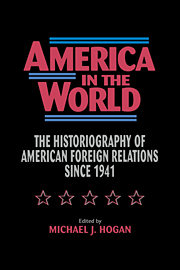Book contents
- Frontmatter
- Contents
- Preface
- The Authors
- Part One The State of the Art
- Part Two The Historiography of American Foreign Relations since 1941
- 6 The Historiography of American Foreign Relations: An Introduction
- 7 A Half-Century of Conflict: Interpretations of U.S. World War II Diplomacy
- 8 The Decision to Use the Bomb: A Historiographical Update
- 9 Origins of the Cold War in Europe and the Near East: Recent Historiography and the National Security Imperative
- 10 Making Known the Unknown War: Policy Analysis of the Korean Conflict since the Early 1980s
- 11 Eisenhower Revisionism: The Scholarly Debate
- 12 John F. Kennedy as World Leader: A Perspective on the Literature
- 13 The Unending Debate: Historians and the Vietnam War
- 14 Complaints, Self-Justifications, and Analysis: The Historiography of American Foreign Relations since 1969
- 15 An Emerging Synthesis? U.S.–Latin American Relations since the Second World War
- 16 Gideon's Band: America and the Middle East since 1945
- 17 The Cold War in Asia: The Elusive Synthesis
- 18 The Power of Money: The Historiography of American Economic Diplomacy
- 19 Coming in from the Cold War: The Historiography of American Intelligence, 1945–1990
- Index
8 - The Decision to Use the Bomb: A Historiographical Update
Published online by Cambridge University Press: 05 June 2012
- Frontmatter
- Contents
- Preface
- The Authors
- Part One The State of the Art
- Part Two The Historiography of American Foreign Relations since 1941
- 6 The Historiography of American Foreign Relations: An Introduction
- 7 A Half-Century of Conflict: Interpretations of U.S. World War II Diplomacy
- 8 The Decision to Use the Bomb: A Historiographical Update
- 9 Origins of the Cold War in Europe and the Near East: Recent Historiography and the National Security Imperative
- 10 Making Known the Unknown War: Policy Analysis of the Korean Conflict since the Early 1980s
- 11 Eisenhower Revisionism: The Scholarly Debate
- 12 John F. Kennedy as World Leader: A Perspective on the Literature
- 13 The Unending Debate: Historians and the Vietnam War
- 14 Complaints, Self-Justifications, and Analysis: The Historiography of American Foreign Relations since 1969
- 15 An Emerging Synthesis? U.S.–Latin American Relations since the Second World War
- 16 Gideon's Band: America and the Middle East since 1945
- 17 The Cold War in Asia: The Elusive Synthesis
- 18 The Power of Money: The Historiography of American Economic Diplomacy
- 19 Coming in from the Cold War: The Historiography of American Intelligence, 1945–1990
- Index
Summary
To commemorate the fiftieth anniversary of the end of World War II, the National Air and Space Museum, a part of the Smithsonian Institution, made plans for an exhibit featuring a section of the fuselage of the Enola Gay, the plane that dropped the atomic bomb on Hiroshima in August 1945. Curators consulted with an advisory committee of experts on the use of the bomb in an effort to ensure that the exhibit was historically accurate and consistent with recent scholarly findings. Although museum officials were acutely aware that the subject was controversial, they were ill-prepared for the outrage that early drafts of the script triggered. Veterans' groups led a fusillade of attacks that accused the Smithsonian of making the use of the bomb appear aggressive, immoral, and unjustified. The Wall Street Journal, for example, condemned “scriptwriters [who] disdain any belief that the decision to drop the bomb could have been inspired by something other than racism or blood-lust.”
Eventually, the Smithsonian modified its script in response to the complaints of veterans, members of Congress, and a chorus of other critics. This, in turn, elicited protests from scholars that the museum had sacrificed historical accuracy to accommodate political pressures. The outcry over the Smithsonian's exhibit plans vividly demonstrated that the decision to use the bomb remained an emotionally charged issue, even nearly half a century after the end of World War II.
- Type
- Chapter
- Information
- America in the WorldThe Historiography of US Foreign Relations since 1941, pp. 206 - 233Publisher: Cambridge University PressPrint publication year: 1996
- 1
- Cited by

